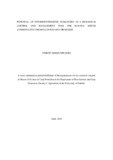| dc.description.abstract | Banana weevil (Cosmopolites sordidus) as a pest has been identified as a major pest
hindering sustainable banana production in Kenya and throughout the tropics in the world.
Most damage is caused by the larvae that tunnel through the corm consequently interfering
with nutrient, water intake and stability of the banana pseudostem and eventual reduction of
yields. The study was carried out to determine the potential of local entomopathogenic
nematodes as a sustainable biological management tool against the banana weevil.
Firstly, a survey was carried out where 90 farmers were interviewed to determine biotic
constraints affecting small holder banana production. While administering the questionnaires
the incidences of banana pests and diseases were determined on 30 farms. Secondly, a study
on the prevalence of banana weevil in three identified agro-ecological zones, upper midlands
1, 2 and 3 (UM 1, UM 2 and UM 3, respectively), in two banana growing areas, Maragua in
Central Kenya and Embu in Eastern Kenya was done. Banana weevils were trapped from 30
banana farms randomly spread in each zone (10 farms per zone) using pseudostem
attractants, made of one foot length pseudostems split into two halves with the fresh side
placed on the soil. Lastly, bioassays with adult weevils and larval stages were carried out in
the laboratory to determine the pathogenicity and virulence of Kenyan Entomopathogenic
nematode (EPN) species as a potential biological control and management tool for banana
weevil.
Results showed that more than a third of the farmers interviewed grew banana as a major
crop purposely for income generation. About half of the farmers were aware of banana pests
and diseases by their ability to identify symptoms of damage for both pests and diseases
known to them while the other half was not to aware. The farmers perceived that the banana
weevil and yellow sigatoka disease at 51% and 43%, respectively were the biotic major
constraining factors. Incidences of banana weevil and sigatoka disease were significantly
xiii
(P<0.05) affected by the environmental conditions experienced in the different agroecological
zones. Other pests and diseases observed included thrips, nematodes, panama and
cigar-end rot diseases. Agro ecological zone environmental conditions significantly (P<0.05)
affected the mean population of banana weevils with the lower altitude zone (UM 3)
recording the highest number of banana weevils in Maragua region in both seasons. Embu
region had the same trend but there were no significant difference between the mean
populations of weevils recorded in the different agro ecological zones. Temperature has a role
to play where lower areas with high temperatures recorded high occurrence of the weevil
compared to the cooler areas.
Entomopathogenic nematodes did not parasitize the adult weevils hence no mortality was
observed. The test EPNs significantly (P<0.05) affected the mortality of banana weevil
larvae. Steinernema carpocapsae was the most virulent while Steinernema yirgalemense was
the least virulent. Nevertheless; all the test nematodes caused more than 90 % larval
mortality.
This study has demonstrated that C. Sordidus a serious pest of bananas and that its incidence
and occurrence is influenced by agro-ecological zone conditions. The control and
management adopted by the farmers like, trapping, pruning, uprooting and the cutting down
of banana crop are inadequate to deal with the banana weevil in the farms. This research has
also demonstrated that the use of local EPNs can be utilized to control and manage banana
weevil by targeting the larval stage described which is the most destructive stage to bananas. | en_US |



